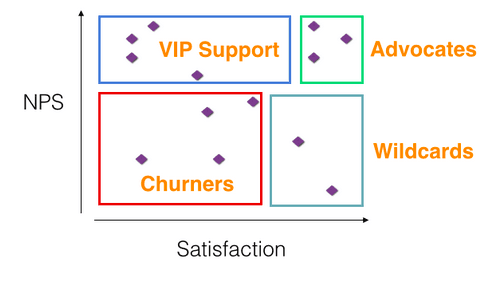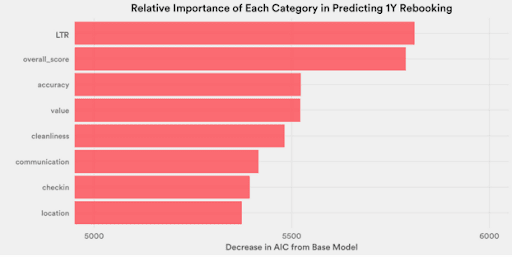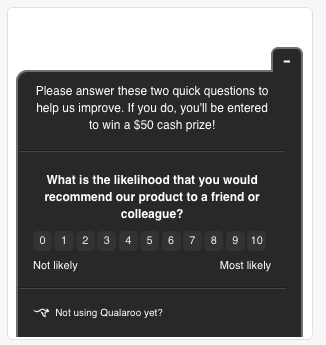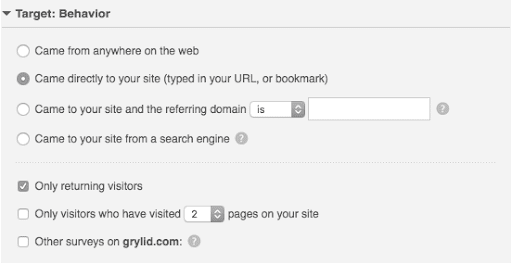In the last two previous chapters, we've learned how to create impeccable surveys, when and where to launch, and the methods available to calculate the NPS.
After all this crucial information, the time has come to discuss the industry's best practices for NPS surveys. We have 12 NPS best practices up our sleeves, so you never go wrong with your NPS surveys.
1. Competitive Analysis
If you consistently get a low or negative NPS, there are serious underlying issues you need to address. One way to identify these issues is through competitors’ analysis.
Monitoring your competitors and their strategies lets you get an idea of industry NPS benchmarks and your performance.
So, before you launch an NPS survey, you can deploy marketing surveys asking website visitors about your competitors and what they would like improved in your product/service/website. This way, you get contextual feedback to work on those areas to ensure you get high NPS.
2. Measure NPS Against Other Metrics
NPS gives you insights into how many and which customers are happy or on the verge of churning out.
If the customers are happy, they’ll be willing to recommend your brand, products, and services to others. And if they are not, a low NPS isn’t your only problem; you’ll be dealing with a severe case of bad word-of-mouth.
NPS is a great indicator of growth down the line, but on its own, it doesn't work well as a predictor of customer behavior. One of the net promoter score survey best practices is to measure NPS against other customer satisfaction metrics.
For example, NPS surveys can give you a bigger picture of general customer consensus towards your company. Still, customer satisfaction (CSAT) metrics will evaluate their satisfaction level after specific interactions or touchpoints.
Measure NPS against other customer data—reviews, customer satisfaction scores, or whatever metric you use to get a transactional measure of customer satisfaction.
You can also leverage Omnichannel Customer Experience (OCX) metric that tracks experience across different channels like:
-
Advocates: These are the customers who are telling their friends about you.
-
Wildcards: These customers are bear watching. They've been satisfied with your support system but have troubling NPS scores. So, send a more detailed survey to a sample from this audience to figure out what makes them tick.
-
VIP Support: These are loyal customers who might have recently had poor experiences with your company. Reach out to them through customer success, and you can still prevent them from churning.
-
Churners: These customers are about to leave your service, so you should intervene immediately.
When you weigh NPS against customer satisfaction metrics, you can create an action plan for each customer segment and close the feedback loop. This way, you’ll be able to identify your customers’ requirements and areas of improvement to offer a delightful customer experience.
Here's an example of how Airbnb uses NPS insights to predict rebookings and referrals:
Airbnb's data science team looked at NPS data for over 600,000 customers and found that only 2% of these customers were detractors. They found that the highest NPS scores increased the likelihood of referral by 4% for customers and rebooking rates by 13%.
While most companies would have been satisfied, the team decided to take a deeper plunge into the data to model rebooking rates and the likelihood of referral.
Source
Although the likelihood to recommend (LTR) or NPS score was the strongest way to predict future rebookings, Airbnb found that the other most important factors were the accuracy of the listing and the cleanliness of the rental.
With this information, the company could buckle down on increasing customer referrals.
3. Make Your Support Service Experience a Game-Changer
Did you know that 78% of customers are willing to forgive mistakes by a company and will continue to be a customer if they get quality customer service?
Or that 89% of customers are likely to make another purchase after a positive customer service experience?
How are these statistics related to NPS?
If an incredible customer service experience can lead to customers giving you second chances and improving your customer retention rate, consider the positive impact it will have on your NPS.
If you ask customers whether they are willing to recommend you to others after satisfactory customer service, customers will be motivated to rate to 9 or 10 on the survey, as opposed to low scores after a painful service experience.
So, how can you ensure you offer exemplary customer service?
Here are a few recommendations:
-
Reduce your Average Handling Time (AHT), First Response Time (FRT), and First Contact Resolution (FCR)
-
Leverage live chat tools like ProProfs Chat to proactively approach customers in need using automated chatbots
-
Introduce self-help functionality using tools like a knowledge base. This way, customers won’t have to rely on chat support for small queries, giving more time to your personnel to look into customers with severe issues.
4. Always Close the Feedback Loop
There’s no point in collecting heaps of qualitative and quantitative data if you’re not going to act on the insights. Closing the feedback loop means acknowledging the feedback beyond just analyzing it.
It includes taking appropriate actions, improvising business strategies, and ensuring the feedback reaches the right ears. For example, tools like BIGContacts create a bridge between teams to streamline the feedback among departments.
So, even a small step, like reaching out to your detractors to get a detailed account of their experience, will be a big start in closing the feedback loop.
But what if you’re still waiting on feedback from a chunk of customers?
In that case, you can follow up on your NPS survey to improve your response rate.
5. Perform Root Cause Analysis
A critical part of closing the feedback loop is the root cause analysis. It helps if you’ve deployed NPS surveys at multiple touchpoints in the customer journey to collect contextual NPS feedback.
How?
You’ll be able to get to the main cause of your low NPS at each touchpoint. For example, say you deployed an NPS survey at the onboarding phase and got a low NPS.
With root cause analysis, you’ll be able to find what your onboarding process lacks and how the concerned department can fix it.
6. Customize Your Surveys
Sometimes answering surveys about a product can be quite burdensome. And so getting the customers interested is the main task. Something that can be done by making the surveys aesthetically pleasing and functional.
It's a pretty effective NPS best practice.
The first thing you should do when launching an NPS survey is to adjust the fonts, colors, and text sizes to match your company's design.
The survey should be part of your product and match the overall brand aesthetic to offer customers consistent brand experience and messaging.
In addition to design, the text you add to the survey also plays an important role. It should be relevant to your audience while being respectful.
Here are some other practical NPS best practices to make your NPS survey's UI sleek and inviting for users.
- Keep it all on one page
Don't make users load up a whole new page to fill out the survey. If you use Qualaroo, they can complete it on the same page you prompt the survey. That speeds things up and tells them that this will be quick and easy.
- Emphasize the minimal time commitment
One of the big advantages of NPS is how short it is, so make that clear upfront. Start your survey with a description telling users that the survey is only two questions long. Then, reinforce that with a progress bar to hammer home how little time the survey will take.
- No emails, No usernames
Don't force customers to enter their email addresses or create a username before filling out the survey. That's just an extra hoop for them to jump through. All they should have to do is click "Yes" to agree to take the survey, enter their NPS number, give a brief reason, and get on with their day.
Those tactics do more than ensure a smooth experience. They also signal to customers how easy the survey will be, making them more willing to participate.
Read Also: Marketer’s Guide To Surveying Users
7. Reach out to the Right Audience
Another one of the top NPS practices is reaching out to the right people. Even before starting the survey, it is worth roughly calculating how many people will be involved.
Too small or too large an audience will not give you correct results. For example, if your NPS survey aims at people who purchased in the last month, make sure there are enough people, so you get the appropriate amount of feedback.
Also, don't fret if your response rate isn't as high as you had hoped.
8. Segment Your Users
Taking the above point further, if you want your survey analysis to offer meaningful insights, you need to ask the right questions. But beyond that, you also need to ask the right people.
That’s where the NPS analysis best practices like targeting and segmenting customers help. You can do so based on the purpose of your survey and the kind of insights you want.
But that's not the only way to segment customers. There is more than one voice of the customer that speaks for them all. On its own, your average NPS score isn't that helpful.
For example, you might have a whole bunch of free-trial promoters, but if you only looked at your average score, this would obscure the handful of far more valuable enterprise detractors at risk of churn.
Each group of customers has a voice you need to isolate and respond to. The only way to separate the signal from the noise and get actionable insights from NPS is to start segmenting your customers.
Bonus Read: 10 Best Voice of the Customer(VOC) Tools to Measure CX
You can segment by product. For example, if you want to measure your NPS for a specific product, then make sure to segment customers for that particular product.
The second way is to segment by persona. For example, you wouldn't try to up-sell a small business to your premium enterprise plan, and you probably wouldn't offer them the same level of support either.
Each grouping of customers has different needs, and their NPS scores can tell you something different.
You can try bucketing NPS scores by type of customer. For example, if you're a SaaS business that offers a free trial, the NPS rating of someone on that trial will look very different from that of a customer paying you cold, hard cash.
Based on the data, you can create even more detailed segments through NPS:
-
Look at NPS scores for unconverted free trial promoters who have `< 2` days left in their trial, and have your sales team reach out to them. In terms of customer acquisition, this is low-hanging fruit.
-
Look at passives on the professional plan who have signed up within the last 7 days. These customers are in danger of becoming detractors and churning out.
-
Your enterprise customers are some of your most loyal, so try to create more. Offer enterprise features of your product to qualified, free trial users to convert more of them to the premium plan.
-
Analyze the qualitative answers for enterprise promoters who have been with your service for over six months. Identify commonalities in their answers, from specific features to satisfaction with customer support. Use these insights to try to turn your detractors into promoters.
On its own, your average NPS score gives your company a strong indicator of customer sentiment. But by segmenting your NPS scores, you can turn a simple survey into a systematic plan of action, from closing more sales leads to prioritizing support.
💡 Pro Tip
Integrate NPS scores with individual customers in your existing customer relationship management (CRM) system. That way, you can keep a timeline of how customers feel about your company.
9. Use Emails
As soon as the buyer has interacted with the site/application, for example, made a purchase or solved the issue with the help of technical support, send him an NPS survey.
With this net promoter score best practice, you will be able to get an answer about the new action taken by the client.
The sooner the customer sees it, the better. He will still be able to remember all the nuances of interaction and objectively evaluate it.
It's best if the customers take the survey right in the app as soon as they finish the interaction, but sometimes they can get lost or maybe in a hurry. In that case, it makes sense to send an NPS survey in the mail after a while.
Doing this reduces the likelihood of customers missing your NPS survey.
Related Read: Creating a Customer Satisfaction Survey: Best Practices and More
10. Include Customer Incentives
It's good to use such NPS survey best practices if the percentage of respondents who answered is extremely low. In general, using incentives is discouraged as it reduces the accuracy of the data; however, when other strategies do not work, this option can save the day.
An incentive is the added value of a recently made purchase. It can be used for:
-
Stimulate feedback: Together with NPS, you can ask customers to complete a long survey for a percentage of discount on a new purchase or access to exclusive content and features.
-
An apology: If something goes wrong and the interaction is negative, you can always apologize with a price incentive and change the situation.
-
Rewarding customers for their loyalty: If the same person makes several purchases, you can reward them with a promotional code for a discount in the survey.
Here's a live example:
Three days before sending out a crucial survey to its 6,000 blog subscribers, Groove's marketing team realized they'd made a big mistake.
They'd given their audience no incentive to participate. Groove partnered with other SaaS companies, who agreed to give away a few months on their platforms to lucky respondents. The result? 1,500 people completed the survey.
You're asking customers to do you a favor by filling out an NPS survey, so naturally, they ask, "What's in it for me?" If you can head that question off with an intriguing reward, they'll be much more likely to fill it out.
11. Try A/B Testing
Customers are apprehensive about taking surveys, so why not create surveys that easily grab their attention, motivating them to participate?
A/B testing your surveys is one of the top best practices for NPS. You can use various A/B Testing tools to gather information on what is and isn't working for you.
Use an attractive user interface combined with a custom color scheme. Then analyze how many more people are interacting and answering questions.
12. Hone in on Your Target Audience
The outputs you receive from NPS, or any similar metric, will only be good as your inputs. Many companies have bad data because they "spray and pray." They hit the send button, forget about it, and end up confused by the results.
The key to getting your NPS survey filled out is getting it in front of your customers in the right place at the right time. Understand that when you ask customers for feedback, they're doing you a favor by answering. So, try to make your NPS survey as frictionless as possible.
Use Google Analytics to look at the average time customers spend on the page where you're launching your NPS survey and set your survey to appear accordingly. Three to five seconds is typically the perfect amount of time—any longer, and they'll have moved on to the next page.
In Qualaroo, you can access this in the targeting settings as you set up your survey:
💡 Pro Tip
You'll pull in better NPS survey results if you've timed it to a point in the customer life-cycle where they've had a chance to experience your product. Amazon, for example, triggers email surveys after customers have *finished* reading a book on their Kindle.
one of the easiest ways to start is by targeting direct traffic and repeat visitors to your site.
Direct traffic comes from customers who head to your website, so often, they have it stored in their bookmarks bar or memorized by heart.
Repeat visitors read a blog post you wrote or signed up for a webinar and are typically a good segment to hit with your survey.
You can get even more precise with your surveys:
-
Target customers who are already logged in to your website or mobile app. It is a surefire way of ensuring that these visitors are, in fact, customers.
-
Send surveys every 90 days. NPS helps you keep a running tab on customer loyalty, but only if you develop the habit of periodically sending surveys throughout the customer life cycle. It helps you identify trends all the way from free trial to sign-up.







